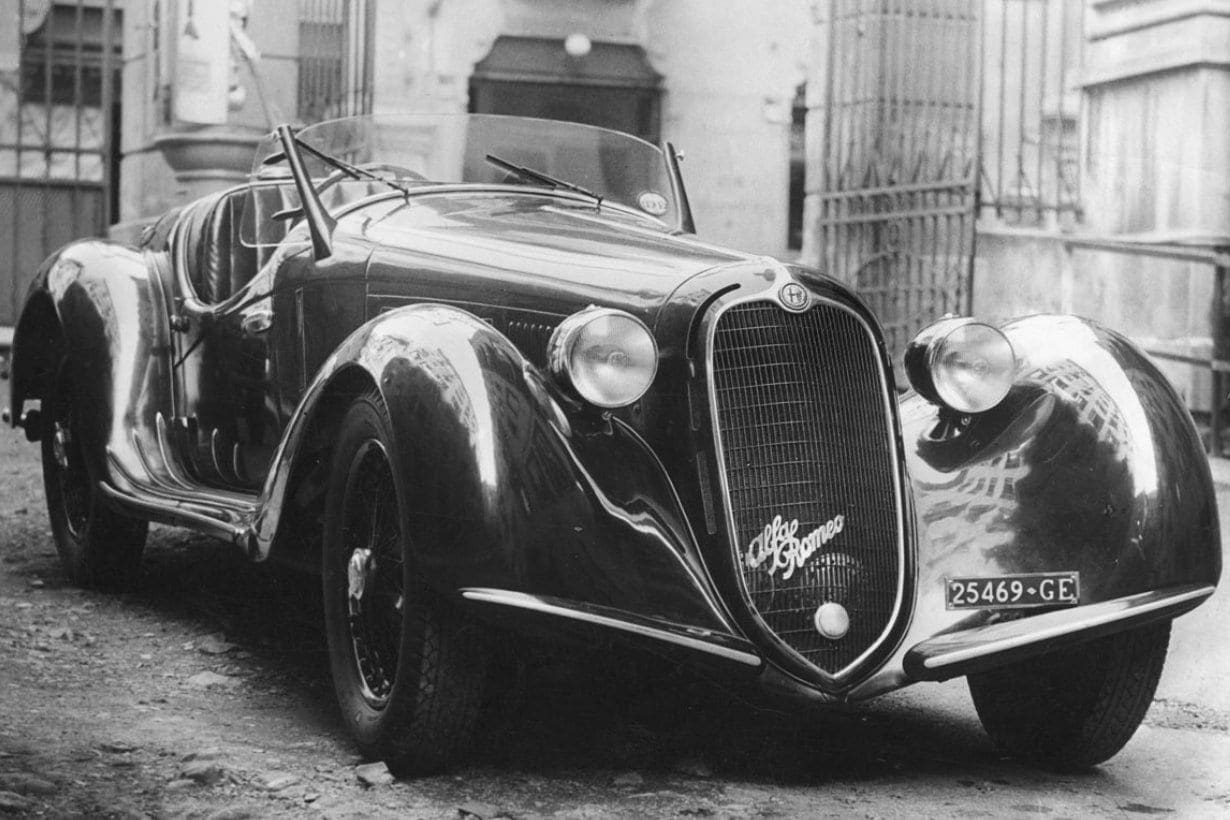Our car is one of only 2 built and finished 2nd in the 1937 Mille Miglia. It is a genuine “barn find” that we found in Argentina through a miraculous series of events.
THESE CARS
The most advanced sports car of the last half of the 1930s was the Alfa Romeo 8C 2900. With double overhead cams and valves, two superchargers, a transaxle, independent four-wheel suspension adjustable from the seat, and a magnificent styling, automotive experts believe that these cars were unbeatable on the track or on the road. The engine had evolved from the Tipo B Grand Prix as a pure racing motor. In the sports car form, these chasses won the Mille Miglia four times, the Spa 24 Hours twice, and many other events.
In 1938, a 2.9 berlinetta led the Le Mans race until an unfortunate blowout prevented it from finishing. Known for both its top speed, efficiency, cornering ability, and overall endurance, Alfa made them for long-distance racing. They converted many of them, such as our 2900A from Grand Prix into sports cars when the racing philosophies changed. They built only a handful of these cars, in various forms, virtually all graced with beautiful bodies usually in roadster configuration. Today they remain the most highly prized pre-war sports car. Their features and successes are beyond enumeration here. I refer the reader to the car-by-car account in Simon Moore’s classic The Immortal 2.9’s.
OUR CAR
This car started life as a pure sports racing car of basic design, comprising a racing body with semicircular fenders in a style later referred to as “botticella”. With fenders and lights, this thinly disguised Grand Prix car qualified for the Mille Miglia, and our car, driven by Farina and Meazza, came in second in that chiliad in 1937. It later raced in Napoli, the Parma-Poggio di Berceto, in Geneva, at the Susa-Moncenisio, the Freiburg Hill Climb, and the Pontedecimo-Giovi. This car apparently entered more races than any other 8C 2900A sports car. By February 1938, someone registered it to a Genovese driver, and its competition activity in Italy ceased.
In the interim since its last race, it had returned to the Alfa Romeo factory and given the beautiful roadster body it now wears. Flowing fenders, cut-down doors, raked windscreen, and slanted radiator all produced the beautiful shape so familiar with Touring bodies. However, the car carries a “Carrozzeria Alfa” badge, signifying they made the body at the Alfa factory. During a conversation with Carlo Felice Bianchi Anderloni, scion of the Touring Carozzeria owners, he shared a story that the Alfa people would have craftsmen from his family’s company down the road come to help in this endeavor, presumably because Alfa did not want to pay for work done outside of the shop.
They later sold the car after the war, and Pietro Ghersi raced in the San Remo Grand Prix and again in the 1947 Circuito delle Cascine race in Florence. By 1949, the car was imported to Argentina by a driver named Raphael Bethenod de las Casas (Count of Montbressieux). He soon sold the car to millionaire banker Ernesto Tornquist, who raced it in Argentina, the last race apparently being in 1952 when he placed fourth at Mar del Plata.
In the early 1970s, I recall reading about this car in a 1952s Road & Track Magazine. It was a simple sentence, and there was no illustration. At the time, I figured there were probably no other 2900A’s on this side of the ocean and that this was a car to look for since I was unaware of the existence of any other 2900A. I made a note of this and put it on a refrigerator magnet. After gaining the 8C 2900B of my dreams (the 1938 Mille Miglia-winning Spider), a 2900A would be the hardest to get in the planned full house of the sports car racing 8C Alfas. 8C 2300 Monzas and Spiders were presumably available (less likely the Le Mans version).
My Argentina contact was Hector Mendizabal, with whom I had corresponded with through Ben Moser. They had found an old Kissel Touring car in Argentina and did not know what to do with it. I arranged for us to donate it to the Kissel museum in Hartford, Wisconsin, where it still lives. Through these connections, began a search for Senõr Tornquist. Now a hermit, he had the car in his shed, protected from the elements but not the pigeons, and when first examined, we saw ut covered with, and perhaps protected by, pigeon droppings.
Hector called me excitedly when it he found it. It was, however, in rough shape, though complete with one major exception, the engine was missing! When we brought the car into light, a metal shell covered the front cowl. They chopped the rear fenders. The front fenders were off and lying in a corner. The rest of the car, including the hood, body, doors, rear spare cover, and rear body section, were intact. The entire chassis, suspension, transaxle, and dash, except for one instrument, were also intact. The upholstery was in superb condition, and, in fact, it still sports one of its original pocketed door panels.
Hector told me that the engine was in another location and that he determined it that I could buy it. I thought they pointed this out to Hector by Mr. Tornquist, but Alfa Romeo expert Simon Moore believes that knowledge of the engine independent of the body preexisted the discovery of the car. Either way, a deal was made both to purchase the car and the engine which, remarkably, was virtually complete.
The extraordinarily rare carburetors, superchargers, and other precious appurtenances were intact. Apparently the engine was dismantled, but the technology in Argentina did not suffice for reassembly, and, fortunately, they carefully stored the pieces with no effort for resurrection. We disassembled the various parts and boxed up so that the car left in pieces to avoid any “national treasure” issues, which stymied the purchase of special art objects, including cars from Argentina. It was not possible to restore the rear fenders.
Simon Moore lent us windshield and door handle castings, the small bonnet louver handles, and Dave George discovered original missing door latches, which were among the few parts that did not come with the car. We later found the other instrument, and I restored both. Alan Kirk did his usual superb job on the fenders and body with artistic élan.
The bare chassis then went to Dave George’s shop for his usual meticulous attention. He went over the car from stem to stern, and although pleased with its level of completeness, virtually everything had work to get it in shape for the installation of the engine which was with Jim Stokes in England being reconditioned. The difficult work of bringing this all together fell to Dave who handled it beautifully. In a reasonably short time, he had the chassis ready for the engine. He received the body, primed and painted it, and fit the entire package together.
After Dave’s restoration, it was magic, and he and I took it to the 1991 Mille Miglia race, where it performed flawlessly. We got caught in a hailstorm, and the top that David made protected us while we completed that a section of the race without having to stop.
Today the car sits as an example of a specifically sought-after car, authenticated by a variety of sources mentioned in Moore’s book. During restoration David discovered the remnants of the stanchions for the cycle fenders it wore when it was in botticella form. The car performs as beautifully as 8C 2900s normally do, and very proud.

I’m enlightened. I finally understand the message that all the great teachers, saints, and visionaries have been trying to convey to man, particularly to middle-aged car nut. Buy an Alfa Romeo 8C 2900A (first, second and third place in the 1936 Mille Miglia) and let the wife and kids go on
P. J. O’Rourkewelfa re.

















